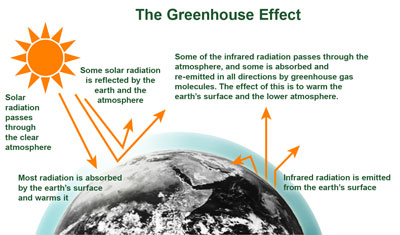What Is the Greenhouse Effect?
Sunlight passes through the atmosphere and warms the Earth’s surface. Some of this solar radiation is reflected by the Earth and the atmosphere. Greenhouse gases in the atmosphere, such as carbon dioxide (CO2), absorb heat and further warm the surface of the Earth. This is called the greenhouse effect.
As more greenhouse gases are emitted into the atmosphere, heat that would normally be radiated into space is trapped within the Earth’s atmosphere, causing the Earth’s temperature to increase.
Graphic Reference:
EPA. 2008q. Climate Change Web site. Climate Change—Science. accessed August 31, 2009.
![[logo] US EPA](https://www.epa.gov/epafiles/images/logo_epaseal.gif)
